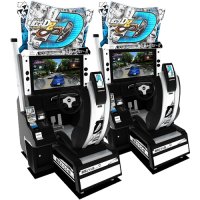Initial D is a manga, anime and video game series about tuning, drifting and racing with a heavy impact on car culture not only in Southeast Asia. But why is that? What makes the Initial D franchise so iconic that it still attracts hundreds of thousands of viewers and players?
Image credit: Avex
The importance of Initial D to the Japanese tuning, drifting and touge scene can hardly be overstated. The Initial D manga series by Shūichi Shigeno's ran in the "Young Magazine" from July 17, 1995 to July 29, 2013, with 719 chapters (48 volumes) published. As of April 2021, Initial D had over 55 million copies in circulation, making it one of the best-selling manga series in history and one of the most iconic and influential car culture franchises.
The equally popular anime Initial D series was produced between 1998 and 2014. It features an excessive use of Eurobeat music, a special trademark also present in the video games. A live-action film of the same name came out in 2005.
On the video games front, there have been around 20 iterations since the mid-1990s. Most of them were developed by Sega, the latest being Initial D THE ARCADE (2021), rendering Initial D the company's major racing game IP. But what exactly makes Initial D so iconic? To find out, we talked to two experts and insiders from Sega, Toyohito Tamari and Kenji Arai.
 Initial D THE ARCADE from 2021. Image credit: Sega
Initial D THE ARCADE from 2021. Image credit: Sega
 Toyohito Tamari, Director of Initial D THE ARCADE. Image credit: Sega
Toyohito Tamari, Director of Initial D THE ARCADE. Image credit: Sega

Initial D Arcade Stage Ver.2
 Kenji Arai, Producer at SEGA. Image credit: Sega
Kenji Arai, Producer at SEGA. Image credit: Sega

Image Credit: Wikipedia
One day, the Akagi Redsuns challenge the Akina Speedstars to a race. There is no one in the Speedstars who even comes close to the Redsuns brothers Ryousuke and Keisuke Takahashi. But suddenly a completely outdated AE86 appears in Keisuke's rearview mirror and defeats him outright. It becomes known that Takumi was the driver of the AE86. Keisuke wants revenge. The Speedstars are happy to have found a competitive man and send him into battle. Takumi reluctantly joins in because he does not think much of street racing. However, he wins a second time, and then the racer in him awakens. The rest of the series is about the duels against his opponents and how he slowly learns to master his car.
Arai-san: The original comic book Initial D is very captivating. The anime and live-action movie based on the original manga have been extremely popular in Japan and other Asian countries, which is undoubtedly the reason for its popularity. But the game also has a strong appeal that other racing games do not possess. Namely, the ability to have fun through 1-vs-1 competitions, which is unparalleled in other racing games.
 Characters, cars and rivalry are the foundation and source of fascination in Initial D. Image credit: reddit
Characters, cars and rivalry are the foundation and source of fascination in Initial D. Image credit: reddit
How do you like this feature? What do you think of Initial D? Tell us on X (Twitter) at @OverTake_gg or in the comments down below!
Image credit: Avex
The importance of Initial D to the Japanese tuning, drifting and touge scene can hardly be overstated. The Initial D manga series by Shūichi Shigeno's ran in the "Young Magazine" from July 17, 1995 to July 29, 2013, with 719 chapters (48 volumes) published. As of April 2021, Initial D had over 55 million copies in circulation, making it one of the best-selling manga series in history and one of the most iconic and influential car culture franchises.
The equally popular anime Initial D series was produced between 1998 and 2014. It features an excessive use of Eurobeat music, a special trademark also present in the video games. A live-action film of the same name came out in 2005.
On the video games front, there have been around 20 iterations since the mid-1990s. Most of them were developed by Sega, the latest being Initial D THE ARCADE (2021), rendering Initial D the company's major racing game IP. But what exactly makes Initial D so iconic? To find out, we talked to two experts and insiders from Sega, Toyohito Tamari and Kenji Arai.

Interview With SEGA's Toyohito Tamari And Kenji Arai
OverTake: Tamari-san, how did you go from being a top player in Initial D THE ARCADE to the director of Initial D THE ARCADE?
Tamari-san: It all started when I became interested in game development by attending official events and I learned that there were part-time jobs available. I had never imagined being involved in game development up until that point in my life. But I decided to apply for the job because I knew I would not have many opportunities to be involved in a title that had such a big impact on my life. After joining the company, I started by supporting game coordination, then I held a planning position. And after I was put in charge of game design, I soon became a director. Although I had no experience in game development, I was able to acquire the necessary skills thanks to guidance from senior staff and support from the company. The environment in which this kind of career can be realized may be characteristic of SEGA as a company.
OverTake: Where and how did your passion for Initial D begin?
Tamari-san: My first encounter with Initial D was in my childhood when my father, a car enthusiast, was watching a videotape of the anime at home. After that, I became even more excited about Initial D than my father, and we watched it over and over at home. Later, I stumbled upon Initial D Arcade Stage Ver.2 inside a shopping mall and began playing.
Initial D Arcade Stage Ver.2
OverTake: Arai-san, how did SEGA start working on Initial D?
Arai-san: I loved the original story of Initial D. I had been involved in the development of SEGA Rally and SEGA Touring Car Championship as a graphic designer, and I thought it was critical to weave together the history of SEGA’s racing games. The management team, including my boss, supported this idea.
The Story Of Initial D
Set in the late 1990s, Initial D tells the story of Takumi Fujiwara, an 18-year-old teenager who helps in his father's tofu business by leaving the hotel on Mount Akina every morning in his Toyota Sprinter Trueno AE86. Thanks to his daily rides Takumi becomes an exceptionally good driver, but he has no interest in street racing at first.
Image Credit: Wikipedia
One day, the Akagi Redsuns challenge the Akina Speedstars to a race. There is no one in the Speedstars who even comes close to the Redsuns brothers Ryousuke and Keisuke Takahashi. But suddenly a completely outdated AE86 appears in Keisuke's rearview mirror and defeats him outright. It becomes known that Takumi was the driver of the AE86. Keisuke wants revenge. The Speedstars are happy to have found a competitive man and send him into battle. Takumi reluctantly joins in because he does not think much of street racing. However, he wins a second time, and then the racer in him awakens. The rest of the series is about the duels against his opponents and how he slowly learns to master his car.
OverTake: What do you think are the reasons why Initial D has become so popular and iconic as a series and as an arcade game?
Tamari-san: There are many reasons. Being able to relive the world of Initial D, the ability to easily swerve through mountain passes, or the many variations in customization. Just to name a few. But I believe that the most fundamental aspect is the battle element. I also love and often play simulated racing games on console and PC. But Initial D offers a kind of battle that I can’t experience in other racing games. As well as offering many thrills. In fact, many of Initial D’s top players started out not knowing much about cars, or became interested in cars through Initial D. They often started playing Initial D as a competitive game. I believe that the fact that fans support it for being not only a racing game but also a competitive game is the reason why it has continued for 20 years.Arai-san: The original comic book Initial D is very captivating. The anime and live-action movie based on the original manga have been extremely popular in Japan and other Asian countries, which is undoubtedly the reason for its popularity. But the game also has a strong appeal that other racing games do not possess. Namely, the ability to have fun through 1-vs-1 competitions, which is unparalleled in other racing games.
OverTake: In what respect exactly?
Arai-san: Unlike racing games up until this point, rivals are not "obstacles on the course”. Players can enjoy one-on-one battles with Initial D characters, just like in the original comics. Those who are familiar with the comics will naturally enjoy the game too. And those who haven’t read the original series will still enjoy the rich storyline. Players can also compete against each other 1 vs 1. Unlike past racing games, battles are not limited to those within the same arcade, but players can compete with others from different arcades. Initial D is the only arcade game that allows for one-on-one battles between stores over the internet, both in the past and at present. You can even play against people across borders.OverTake: What is the target audience for Initial D THE ARCADE?
Arai-san: Of course fans of the original Initial D series but also those who like competitive games, love cars, enjoy racing and so on. For my part, I hope that by playing Initial D players will come to love cars as much as I do. We also see future car owners as an important target segment.
OverTake: Is there a strong community surrounding the arcade racing scene?
Tamari-san: The Initial D community exists not only in Japan but also in other Asian countries. In particular, the online community that comes together through online battles is a unique feature of Initial D THE ARCADE. When players visit different parts of the world, it is common to see them communicating on social media and playing together at local arcades. I myself have friends who I have been in contact with. Not only players in Japan but also those in other Asian countries ever since I was a player. So the Initial D THE ARCADE actually makes these encounters possible.OverTake: How has Initial D THE ARCADE influenced video games in general and the arcade racing scene in particular?
Arai-san: Without the success of Initial D, there might not have been racing games in arcades today. In particular, the success of Initial D also led to the appearance of “characters” within racing games released in Japan and Southeast Asia. I believe that this has influenced the diversification of racing games overall.More SEGA + Virtual Racing
Initial D has become iconic due to its unique blend of characters, cars, music, and, most of all, racing. For many, it is simply the best racing anime series ever made. Though important, it is only one part of SEGA's rich and varied impact on the virtual racing scene. Be sure to also check out our other articles on our "SEGA Week" on Race Department:- The Incredible World of the Japanese Arcade Racing Scene
- Why OutRun Is The Perfect Arcade Racing Game
- Top 7 Best SEGA Racing Games of All Time
How do you like this feature? What do you think of Initial D? Tell us on X (Twitter) at @OverTake_gg or in the comments down below!


